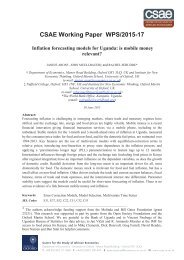You also want an ePaper? Increase the reach of your titles
YUMPU automatically turns print PDFs into web optimized ePapers that Google loves.
equations (Equation 5-7) for OLS estimation.<br />
y t = β 1 y t−1 + β 2 (i t−1 − π t−1 ) + φq t−1 + η y,t (5)<br />
π t − π t−1 = β 3 y t−1 + η π,t (6)<br />
q t − q t−1 − (i t−1 − π t−1 ) = δ(i t−1 − i t−2 ) + η q,t (7)<br />
Equation 5 is a discrete-time simplified version of the IS and aggregate demand equations.<br />
It coincides with the equilibrium in the goods market, whereby the amount of goods being<br />
supplied by producers equal the amount of goods demanded by consumers. This equation also<br />
corresponds to the amount of money people save equal to the amount of money that people<br />
invest. An increase in the real interest rate leads to higher cost of borrowing and higher cost of<br />
capital, which then leads to lower investments and lower output. We expect β 2 to be negative<br />
as it captures the negative causal relationship between real interest rate (nominal interest rate<br />
less inflation rate) and output gap. Current output gap also depends on the output gap in<br />
the previous quarter. We expect β 1 to be positive and less than 1 such that the actual level<br />
of output will converge back to its natural level in the medium run as the theory generally<br />
predicts.<br />
In an open economy, output gap can also be affected through an additional channel which<br />
is the real exchange rate, q. The inclusion of the real exchange rate into the IS equation should<br />
be very important for an economy like New Zealand. New Zealand is a small and open economy<br />
that can be adversely affected by the exchange rate and the relative price between New Zealand<br />
and its major trading partners.<br />
An increase in the real exchange rate makes New Zealand<br />
goods relatively more expensive for its trading partners.<br />
This is expected to lower exports<br />
(assuming elastic demand for New Zealand exports), increase New Zealand imports of foreign<br />
goods (assuming elastic demand for imports) and ultimately leads to a decrease in output gap.<br />
The theory thus predicts that φ be positive. However, as we have discussed in Section 2, we<br />
14





